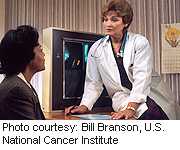- Double Mastectomy May Offer No Survival Benefit to Women With Breast Cancer
- Toxic Lead Found in Cinnamon Product, FDA Says
- Certain Abbott Blood Sugar Monitors May Give Incorrect Readings
- Athletes Can Expect High Ozone, Pollen Counts for Paris Olympics
- Fake Oxycontin Pills Widespread and Potentially Deadly: Report
- Shingles Vaccine Could Lower Dementia Risk
- Your Odds for Accidental Gun Death Rise Greatly in Certain States
- Kids From Poorer Families Less Likely to Survive Cancer
- Tough Workouts Won’t Trigger Cardiac Arrest in Folks With Long QT Syndrome
- At-Home Colon Cancer Test Can Save Lives
Terms Docs Use Can Influence Patients’ Cancer Choices


MONDAY, Aug. 26The way doctors describe precancerous conditions can affect the treatment choices patients make, potentially steering them toward surgery if more dire terms are used, a new study finds.
Researchers found that women more often chose surgery as treatment rather than medication or observation if the word “cancer” was used when describing a diagnosis of ductal carcinoma in situ, or DCIS, a noninvasive form of breast cancer, according to the study, which was supported by the American Cancer Society.
Two-thirds of women opted for a nonsurgical treatment if doctors did not use the term “cancer” when describing DCIS, the researchers reported in the Aug. 26 online issue of JAMA Internal Medicine.
“There’s a strong connotation associated with the term ‘cancer,'” said study co-author Elissa Ozanne, an associate professor in the Institute for Health Policy Studies and department of surgery at the University of California, San Francisco Medical Center. “This study suggests women aren’t receiving the treatments they would prefer if they received a different kind of communication.”
Much attention has been focused recently on the effect that terminology can have on patients with precancerous conditions. In July, a panel of experts commissioned by the U.S. National Cancer Institute concluded that the word “cancer” may need to be redefined to prevent overdiagnosis and overtreatment of conditions that are often not lethal.
The new study involved 394 healthy women who were asked what treatment option they would prefer for a diagnosis of DCIS, which is a noninvasive malignancy involving the presence of abnormal cells inside a breast’s milk duct.
DCIS is not full-fledged breast cancer. “The actual words ‘in situ’ mean ‘noninvasive,’ but over the last 20 to 30 years we started referring to it as cancer,” said Dr. Otis Brawley, chief medical officer of the American Cancer Society. “It has become something people fear as if it is cancer, simply because people started calling it cancer. Even the ACS [American Cancer Society] website refers to it as cancer in places.”
DCIS is diagnosed in more than 50,000 women a year in the United States. More than 90 percent of those women opt for either a mastectomy or lumpectomy, Ozanne said.
However, prior research suggests that low-grade DCIS will progress to full-fledged cancer in only about 20 percent of cases, over a time frame of five to 40 years, according to background provided with the study.
Some doctors argue that low-grade DCIS should be placed in the same category as low-grade prostate cancer, a condition that rarely kills men and often is treated with active surveillance, Ozanne and Brawley said.
The women in the study were presented three treatment options: surgery, medication or active surveillance. When doctors used the term “noninvasive cancer” to describe DCIS, 47 percent of the women surveyed said they would ask for surgery.
But only 34 percent said they would want surgery when doctors described DCIS as a “breast lesion.” And the description “abnormal cells” prompted just 31 percent of the women to choose surgery.
“Significantly more women changed their preference from a surgical to a nonsurgical option than from a nonsurgical to a surgical option depending on terminology used,” the researchers concluded in their paper.
There are two main takeaways for health-care professionals from the findings, Ozanne said.
“First, be as careful as possible so women fully understand the risks they face, and understand that the terminology may confer unintended risks,” she said. “Second, really involve the patient in the decision-making, and make sure their informed preferences drive the decision-making.”
Brawley said the findings also add more weight to the argument that the term “cancer” needs to be reassessed.
“We need to realize that we have a problem, and the problem is that everything that looks like cancer is not going to behave like cancer. Because it’s localized and has this appearance doesn’t mean it’s going to grow, spread and kill,” he said. “We have to develop a 21st-century definition of cancer that involves genomic studies. Right now we’re working with an 1850s’ definition of breast cancer, and we’re not even being true to it.”
More information
For more on ductal carcinoma in situ, visit the U.S. National Cancer Institute.
Source: HealthDay
Copyright © 2024 HealthDay. All rights reserved.














